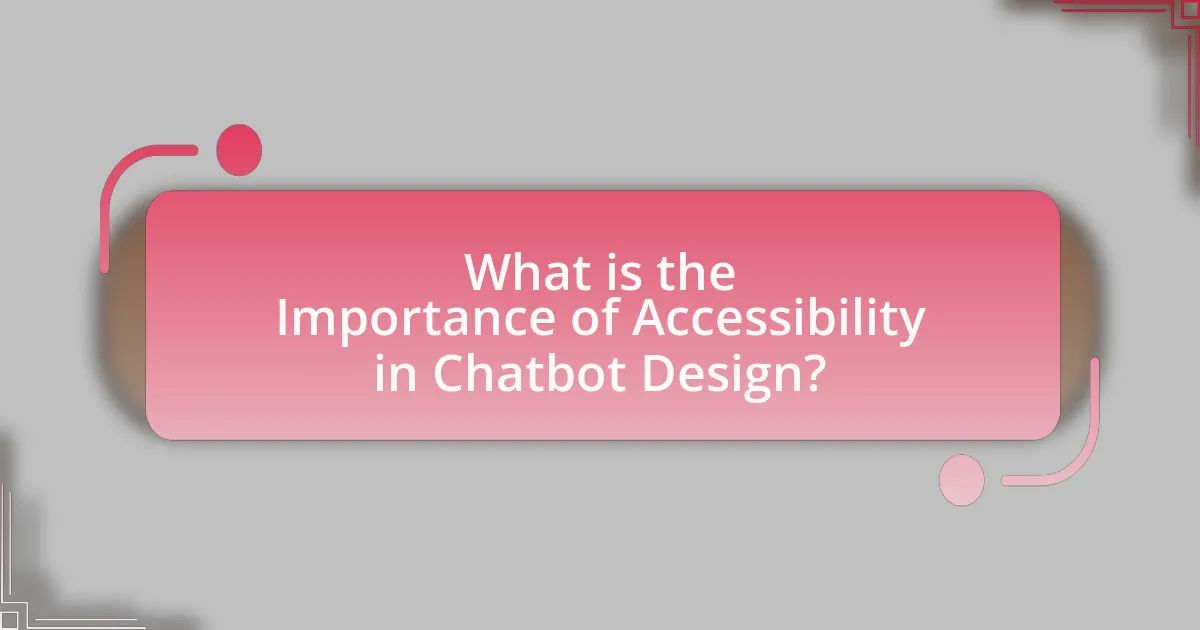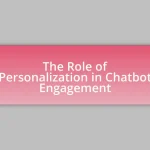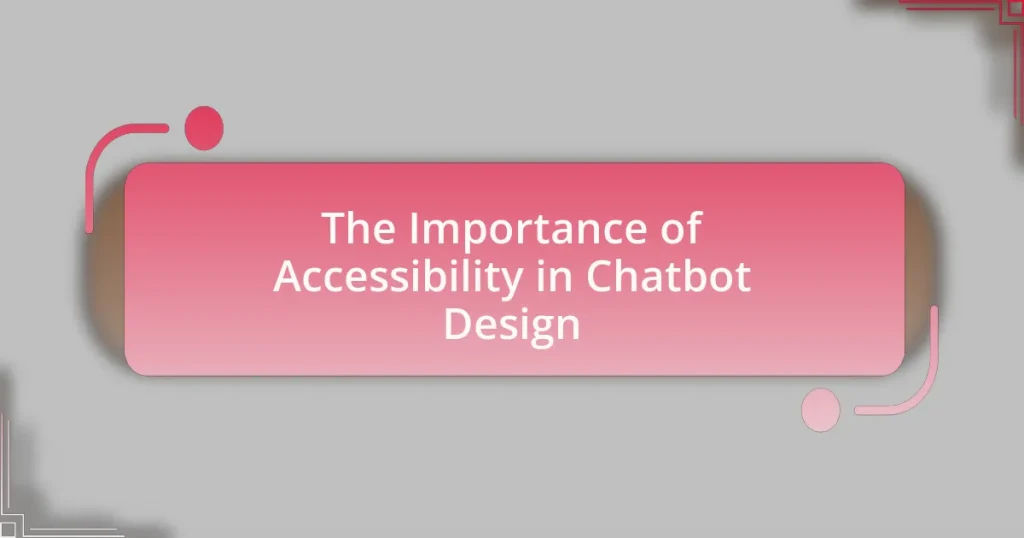The article focuses on the importance of accessibility in chatbot design, emphasizing the need for inclusive technology that accommodates users with disabilities. It outlines key principles of accessibility, such as perceivability, operability, understandability, and robustness, and discusses how these principles enhance user experience and engagement. The article also highlights the demographics most affected by accessibility issues, the common barriers in chatbot design, and the technical challenges developers face. Additionally, it provides practical tips for creating accessible chatbots, the role of AI in improving accessibility, and the impact of regulations on ensuring inclusive design.

What is the Importance of Accessibility in Chatbot Design?
Accessibility in chatbot design is crucial because it ensures that all users, including those with disabilities, can effectively interact with the technology. By implementing accessibility features, such as screen reader compatibility and alternative input methods, designers can enhance user experience and engagement. According to the World Health Organization, over 1 billion people globally experience some form of disability, highlighting the necessity for inclusive design. Furthermore, accessible chatbots can improve customer satisfaction and broaden market reach, as they cater to a diverse audience.
Why is accessibility crucial in the development of chatbots?
Accessibility is crucial in the development of chatbots because it ensures that all users, including those with disabilities, can effectively interact with the technology. By adhering to accessibility standards, such as the Web Content Accessibility Guidelines (WCAG), developers can create chatbots that accommodate various needs, including visual, auditory, and cognitive impairments. Research indicates that approximately 15% of the global population experiences some form of disability, highlighting the necessity for inclusive design. Furthermore, accessible chatbots can enhance user satisfaction and engagement, leading to broader adoption and improved customer service outcomes.
What are the key principles of accessibility in technology?
The key principles of accessibility in technology include perceivability, operability, understandability, and robustness. Perceivability ensures that information is presented in ways that all users can perceive, such as providing text alternatives for non-text content. Operability means that users can navigate and interact with the technology using various input methods, accommodating different abilities. Understandability involves making information and the operation of the technology clear and straightforward, while robustness ensures compatibility with a wide range of user agents, including assistive technologies. These principles are grounded in the Web Content Accessibility Guidelines (WCAG), which provide a framework for creating accessible digital content.
How does accessibility impact user experience in chatbots?
Accessibility significantly enhances user experience in chatbots by ensuring that all users, including those with disabilities, can effectively interact with the technology. When chatbots are designed with accessibility features such as screen reader compatibility, keyboard navigation, and alternative text for images, they become more inclusive, allowing a broader audience to engage with the service. Research indicates that approximately 15% of the global population lives with some form of disability, highlighting the necessity for accessible design to cater to this demographic. By improving accessibility, chatbots not only comply with legal standards, such as the Americans with Disabilities Act (ADA), but also increase user satisfaction and engagement, ultimately leading to higher retention rates and better overall performance.
Who benefits from accessible chatbot design?
Individuals with disabilities benefit from accessible chatbot design, as it ensures they can effectively interact with technology. Accessible chatbots provide features like voice recognition, text-to-speech, and simplified language, which cater to users with visual, auditory, or cognitive impairments. According to the World Health Organization, over 1 billion people globally experience some form of disability, highlighting the necessity for inclusive design. Additionally, businesses benefit from accessible chatbots by reaching a wider audience, improving customer satisfaction, and enhancing brand reputation. Studies show that companies prioritizing accessibility can increase their market share and customer loyalty, demonstrating the dual advantages of accessible chatbot design.
What demographics are most affected by accessibility issues?
Individuals with disabilities, the elderly, and low-income populations are the demographics most affected by accessibility issues. According to the World Health Organization, over 1 billion people globally experience some form of disability, which significantly impacts their ability to access information and services. Additionally, the U.S. Census Bureau reports that approximately 15% of the population is aged 65 and older, a group that often faces challenges related to mobility and technology use. Furthermore, low-income individuals may lack access to assistive technologies, compounding their difficulties in navigating digital platforms. These statistics highlight the critical need for inclusive design in chatbot development to ensure equitable access for all users.
How do accessible chatbots enhance inclusivity for users with disabilities?
Accessible chatbots enhance inclusivity for users with disabilities by providing tailored interactions that accommodate various needs, such as visual, auditory, and cognitive impairments. These chatbots utilize features like text-to-speech, speech recognition, and easy navigation to ensure that all users can engage effectively. For instance, a study by the World Health Organization indicates that over 1 billion people globally experience some form of disability, highlighting the necessity for technology that is universally designed. By implementing accessibility standards, such as the Web Content Accessibility Guidelines (WCAG), chatbots can ensure that users with disabilities have equal access to information and services, thereby fostering a more inclusive digital environment.
What are the common barriers to accessibility in chatbot design?
Common barriers to accessibility in chatbot design include inadequate support for screen readers, lack of multilingual capabilities, and insufficient consideration for users with cognitive disabilities. Inadequate support for screen readers can prevent visually impaired users from effectively interacting with chatbots, as many designs do not provide proper text alternatives for visual elements. Lack of multilingual capabilities limits access for non-native speakers, making it difficult for diverse user groups to engage with the chatbot. Additionally, insufficient consideration for users with cognitive disabilities can result in overly complex language or navigation, which can hinder understanding and usability. These barriers highlight the need for inclusive design practices to ensure that chatbots are accessible to all users.
What technical challenges hinder the creation of accessible chatbots?
Technical challenges that hinder the creation of accessible chatbots include inadequate natural language processing capabilities, lack of support for diverse input methods, and insufficient integration with assistive technologies. Inadequate natural language processing can lead to misunderstandings of user intent, particularly for individuals with speech or cognitive impairments. The lack of support for diverse input methods, such as voice recognition or alternative communication devices, limits accessibility for users with disabilities. Furthermore, insufficient integration with assistive technologies, like screen readers or alternative input devices, can prevent users from effectively interacting with chatbots. These challenges collectively impede the development of chatbots that are truly accessible to all users.
How do design choices impact accessibility in chatbot interfaces?
Design choices significantly impact accessibility in chatbot interfaces by determining how easily users with diverse needs can interact with the system. For instance, the use of clear language, intuitive navigation, and visual contrast can enhance usability for individuals with cognitive or visual impairments. Research indicates that 15% of the global population experiences some form of disability, highlighting the necessity for inclusive design practices. Furthermore, implementing features like text-to-speech and keyboard navigation can facilitate access for users with mobility challenges, ensuring that chatbots serve a broader audience effectively.
How can developers ensure accessibility in chatbot design?
Developers can ensure accessibility in chatbot design by implementing features that accommodate diverse user needs, such as text-to-speech capabilities, keyboard navigation, and clear visual layouts. These features enhance usability for individuals with disabilities, including those with visual impairments or motor difficulties. Research indicates that approximately 15% of the global population experiences some form of disability, highlighting the necessity for inclusive design practices. By adhering to established guidelines like the Web Content Accessibility Guidelines (WCAG), developers can create chatbots that are usable by everyone, thereby improving overall user experience and engagement.
What tools and resources are available for testing chatbot accessibility?
Tools and resources available for testing chatbot accessibility include accessibility evaluation tools, user testing platforms, and guidelines from organizations like the World Wide Web Consortium (W3C). Accessibility evaluation tools such as Axe, Wave, and Lighthouse help identify accessibility issues in chatbots by analyzing their code and user interface. User testing platforms like UserTesting and Lookback allow real users, including those with disabilities, to interact with chatbots and provide feedback on their experiences. Additionally, the W3C’s Web Content Accessibility Guidelines (WCAG) offer comprehensive standards for ensuring digital content, including chatbots, is accessible to all users. These resources collectively support the development of accessible chatbots, ensuring compliance with legal standards and enhancing user experience.
How can user feedback improve accessibility in chatbot design?
User feedback can significantly improve accessibility in chatbot design by identifying specific barriers that users with disabilities encounter. When users provide insights about their experiences, designers can make informed adjustments to features such as text size, voice recognition, and navigation options. For instance, a study by the World Health Organization indicates that over 1 billion people experience some form of disability, highlighting the necessity for inclusive design. By actively incorporating user feedback, chatbot developers can ensure that their systems are usable for a wider audience, thus enhancing overall user satisfaction and engagement.
What are the best practices for creating accessible chatbots?
The best practices for creating accessible chatbots include ensuring compatibility with assistive technologies, using clear and simple language, providing text alternatives for non-text content, and designing for keyboard navigation. Compatibility with assistive technologies, such as screen readers, allows users with visual impairments to interact effectively. Clear and simple language enhances understanding for users with cognitive disabilities. Text alternatives for images and multimedia ensure that all users receive the same information, while keyboard navigation supports users who cannot use a mouse. These practices align with the Web Content Accessibility Guidelines (WCAG), which provide a framework for making digital content accessible to all users.
How can developers implement inclusive language in chatbots?
Developers can implement inclusive language in chatbots by using gender-neutral terms, avoiding jargon, and considering cultural sensitivities. For instance, using “they” instead of “he” or “she” promotes inclusivity for non-binary users. Research indicates that 70% of users prefer gender-neutral language in digital interactions, which enhances user experience and engagement. Additionally, employing simple language ensures accessibility for users with varying levels of language proficiency, as studies show that clear communication increases comprehension by up to 50%. By integrating these practices, developers can create chatbots that are more welcoming and accessible to a diverse audience.
What design elements should be prioritized for accessibility?
Design elements that should be prioritized for accessibility include color contrast, text size, keyboard navigation, and alternative text for images. Color contrast ensures that text is readable against its background, which is crucial for users with visual impairments; for example, the Web Content Accessibility Guidelines (WCAG) recommend a contrast ratio of at least 4.5:1 for normal text. Text size should be adjustable to accommodate users with different visual needs, allowing for a better reading experience. Keyboard navigation is essential for users who cannot use a mouse, enabling them to interact with all elements of the chatbot interface. Lastly, providing alternative text for images ensures that visually impaired users can understand the content through screen readers, which is a fundamental requirement outlined in accessibility standards.
What are the future trends in accessibility for chatbot design?
Future trends in accessibility for chatbot design include enhanced natural language processing capabilities, integration of multimodal interfaces, and increased focus on inclusive design principles. Enhanced natural language processing will allow chatbots to better understand diverse speech patterns and dialects, making them more accessible to users with varying linguistic backgrounds. Integration of multimodal interfaces, such as voice, text, and visual elements, will cater to users with different preferences and needs, improving overall user experience. Additionally, the emphasis on inclusive design principles will ensure that chatbots are developed with consideration for users with disabilities, aligning with guidelines such as the Web Content Accessibility Guidelines (WCAG). These trends reflect a growing recognition of the importance of accessibility in technology, aiming to create more equitable digital interactions.
How is AI influencing accessibility in chatbot technology?
AI is significantly enhancing accessibility in chatbot technology by enabling features such as natural language processing, voice recognition, and personalized user experiences. These advancements allow chatbots to understand and respond to diverse user inputs, including those from individuals with disabilities. For instance, AI-driven chatbots can interpret speech patterns and provide text-to-speech capabilities, making interactions easier for users with visual impairments. Additionally, AI can analyze user behavior and preferences, tailoring responses to meet specific accessibility needs, thereby improving overall user engagement and satisfaction.
What role will regulations play in shaping accessible chatbot design?
Regulations will play a crucial role in shaping accessible chatbot design by establishing mandatory standards that ensure inclusivity for all users. These regulations, such as the Americans with Disabilities Act (ADA) and the Web Content Accessibility Guidelines (WCAG), require developers to create chatbots that accommodate various disabilities, including visual and auditory impairments. Compliance with these regulations not only promotes equal access but also mitigates legal risks for companies. For instance, organizations that fail to adhere to accessibility standards may face lawsuits, as seen in numerous cases where businesses were penalized for non-compliance. Thus, regulations serve as a driving force for the development of accessible chatbot technologies, ensuring that they meet the needs of diverse user populations.
What practical tips can enhance accessibility in chatbot design?
To enhance accessibility in chatbot design, implement features such as text-to-speech capabilities, keyboard navigation, and clear language. Text-to-speech allows visually impaired users to interact with the chatbot effectively, while keyboard navigation ensures that users who cannot use a mouse can still engage with the interface. Using clear and simple language helps users with cognitive disabilities understand the chatbot’s responses easily. Research indicates that 15% of the global population experiences some form of disability, highlighting the necessity for inclusive design practices.










